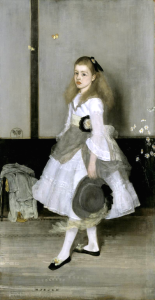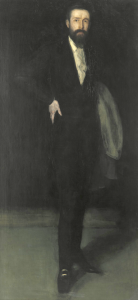Portraits & Patrons
Whistler’s most famous portrait, Arrangement in Grey and Black No.1, Portrait of the Artist’s Mother, opened for the artist the lucrative market of portraiture, which became a stable source of income for him in the 1870s and again in the 1890s.
“Yes, one does like to make one’s mummy just as nice as possible.”
– James McNeill Whistler
Whistler required total control over his art (he designed the frames for his pictures, designed the exhibition space in which his pictures were placed, destroyed paintings and etchings that did not meet his exacting standards) and portraiture was no exception. One sitter described him as “a veritable tyrant.” He instructed his subjects how to stand and what dress to wear, choosing the type of fabric, color of the ribboning and even the type of starch to use.

“Harmony in Grey and Green: Miss Cicely Alexander,” 1872-1874, Oil on canvas. Courtesy of the Tate, London/Art Resource, NY
Sitting for Whistler was an ordeal for most, requiring patience and tolerance. Frederick Leyland called the experience, “my personal martyrdom.” Eight-year-old Cecily Alexander sat for Whistler 70 times, often leaving the studio in tears, for if the artist was not satisfied, he would scrape down the canvas and begin again.
Whistler’s portraits, like his Nocturnes, were always about the arrangement of lines on the canvas, and the color scheme of the palette. They were never truly about making a likeness. They were as much about the artist as they were the sitter. But in every instance, one had a better opportunity of immortality by sitting for Whistler, than not.
Whistler rarely painted a portrait without remuneration; the commissions came largely from patrons who appreciated Whistler’s aesthetics and personality. Banker William Alexander commissioned portraits of two of his daughters; Sir Henry Meux commissioned three portraits of his wife Valerie, an ex-chorus girl, in a campaign to legitimize her position in London society. American millionaire George Washington Vanderbilt commissioned portraits of both himself and his wife.

“Arrangement in Black: Portrait of F R Leyland,” 1870-1874, Oil on canvas. Courtesy of the Freer Gallery of Art, Gift of Charles Lang Freer
Patronage for centuries had been the purview of royalty, the church and the aristocracy. As a result of the Industrial Revolution, the growing and newly wealthy middle class became a new source of support for artists. Whistler had several patrons in his life but the two of greatest significance to him were Charles Lang Freer, the Detroit industrialist who assembled the world’s largest Whistler collection, and Liverpool shipping magnate Frederick R. Leyland.
Leyland had shared Whistler’s interest in Japanese decorative art. Having purchased the costume picture The Princess from the Land of Porcelain, he then commissioned several paintings and etchings, including portraits of both Leyland and his wife.

“Symphony in Flesh Colour and Pink: Portrait of Mrs Frances Leyland,” 1871-3, Oil on canvas, Frick Collection, New York, NY
Leyland had been Whistler’s patron for fifteen years, when their relationship soured. Leyland had purchased a family residence in London, and asked Whistler to touch up the walls of the dining room to better complement the “Princess” which he would hang as the central feature. Without his patron’s permission, Whistler then proceeded to transform the room. He gilded the wooden shelving, painted over the leather walls in designs inspired by peacock feathers, and painted three golden peacocks on the shutters. “As a decoration,” he wrote, “it is thoroughly new and most gorgeous though refined.”
Whistler had spent eight months on the room, and charged 2000 guineas for his work, nearly $300,000 in today’s currency, half of which Leyland refused to pay. Outraged at this slight, Whistler then added a mural of two fighting peacocks: “Art” – a silver plumed Whistler, and “Money” – his Patron, atop a pile of silver coins. Leyland banished Whistler from his house but never changed the Peacock Room, now considered a masterpiece of design.


